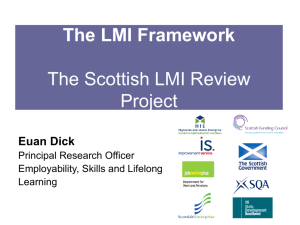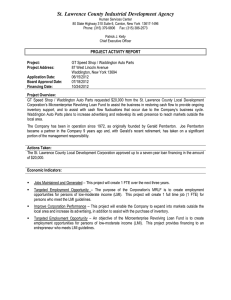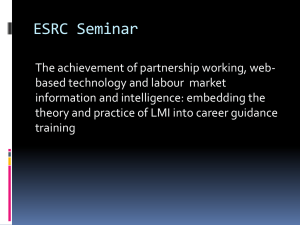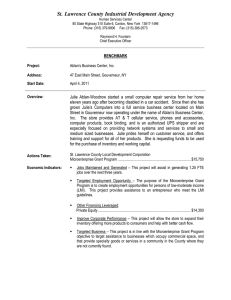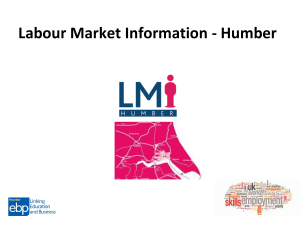IAG Review (2005-2006): Phase 2
advertisement
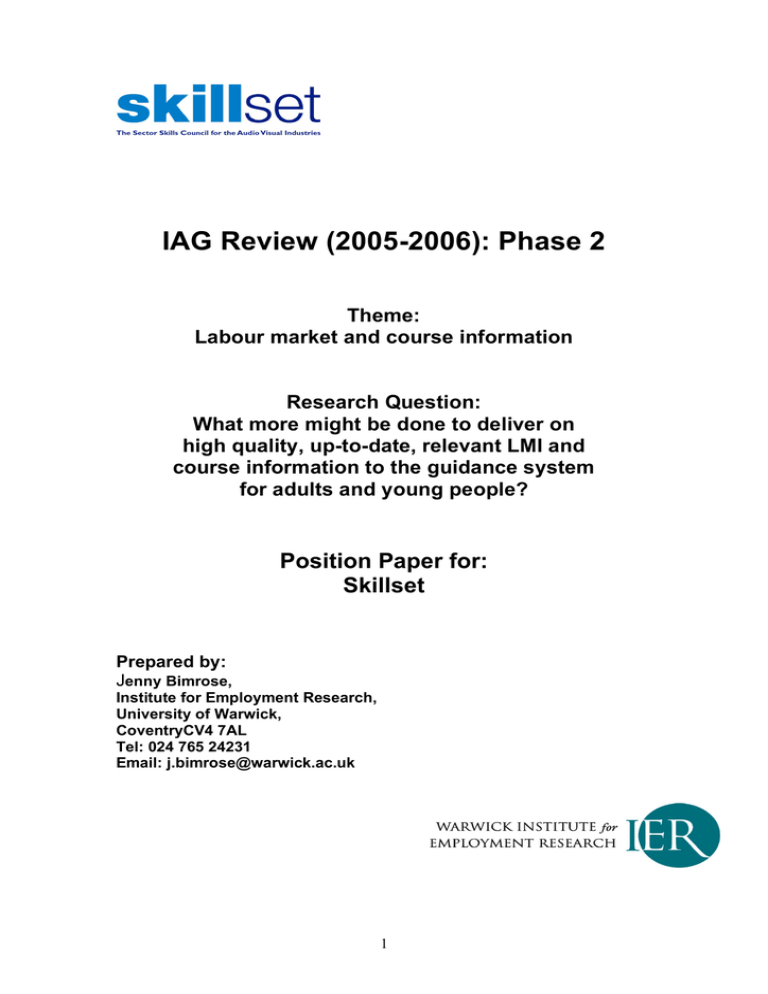
IAG Review (2005-2006): Phase 2 Theme: Labour market and course information Research Question: What more might be done to deliver on high quality, up-to-date, relevant LMI and course information to the guidance system for adults and young people? Position Paper for: Skillset Prepared by: Jenny Bimrose, Institute for Employment Research, University of Warwick, CoventryCV4 7AL Tel: 024 765 24231 Email: j.bimrose@warwick.ac.uk 1 When someone receives good labour market information that leads to a good decision, it benefits the individual, the employer and the economy. (LSC/DfES, 2004, LMI Matters! Sheffield: DfES, p.2) 1 Introduction Labour market information (LMI) is variously defined1 as: • ‘data about the workplace, including employment rates and salary information’; • ‘any information about the structure and working of a labour market and any factors likely to influence the structure and working of that market, including jobs available, people available to do those jobs, the mechanisms that match the two2, changes in the external and internal business environments’; • ‘essentially data, statistics and research about the workplace including things like unemployment rates, salary, demand for, and supply of, labour’. In the context of LMI for information, advice and guidance (IAG), a distinction has been made between labour market information and labour market intelligence, where labour market information refers to quantitative or qualitative data found in original sources such as tables, spreadsheets, graphs and charts, and labour market intelligence relates to an interpretation of labour market information, referring to subsets of information that have been subjected to further analysis3. A further distinction is made between LMI for guidance that is non-interactive and interactive4. Non-interactive LMI is generally linear in nature, is paperbased, often broader in range and more detailed in topic coverage. Its use is limited, however, for motivating further exploratory behaviour in users. Interactive LMI (using ICT) is generally non-linear, with the user maintaining some control over the selection and sequencing information. Whilst it is typically less detailed in topic coverage, it increases motivation for career exploration. 1 Offer, M. (2003) Labour Market Information on Careers Service Web Sites in Higher Education, Cambridge: NICEC. 2 Since course information is part of the mechanism that matches people to jobs, for the purposes of this position paper, no separate distinction will be made. 3 LSC & DfES (2004) LMI Matters! Understanding Labour Market Information, Nottingham: DfES 4 Sampson, J.P. Jr., Reardon, R.C., Peterson, G.W. & Lenz, J.G. (2004) Career Counseling & Services: a cognitive information processing approach, Belmont, CA: Thompson Brooks/Cole. 2 2 Current Position 2.1 Policy The crucial importance of high quality LMI for effective career decision-making has been emphasised in recent policy documents, which focus on the reform of further education and the challenge of developing skills. For example, the review of further education emphasises the need for ‘a relentless focus on the needs of learners and business as the criteria for progress’ (p.6)5. In so doing, the review finds that learners report how ‘information, advice and guidance is out of date, fragmented and ill informed’ (p.39). It also criticises the lack of comprehensive services for adults ‘when and where they need it’ (p.40). About different information sources, the review states that: As a matter of principle, the Government should ensure that the different systems and information sources that exist to help people navigate learner pathways are made more learner-focused, understandable and accessible to improve choice. (Foster, 2005, p.40) Regarding information provided to learndirect, the review states: As a condition of receiving public funding, providers should also be under an obligation to keep the information for these external signposting services current and helpful to potential learners. (Foster, 2005, p.40) In a second recent review, of skills in the UK6, the ‘information failure’ is highlighted as one of the problems to be overcome by a skills policy (p.112). In this context, information failure is defined as follows: Information failure occurs when the information available to individuals and firms is incomplete or not good enough, or when some have more or different information to others. This might be information about the quality and content of courses or the returns they might gain if they complete a course. (Leitch, 2005, p.113) The crucial need for careers information in meeting the economy’s skills needs is further highlighted in the recent prospectus for National Skills Academies (2005/2006). This stipulates that the new Academies will: Play a leading part in developing careers guidance materials for use throughout their sector’s network on the skills and qualifications needed for successful employment in that sector. National Skills Academies Prospectus, 2005/2006, para.2.5). 5 Foster, A. (2005) Realising the Potential: a review of the future role of further education colleges, DfES/LSC. Available [Online]: http://www.dfes.gov.uk/furthereducation/fereview/finalreport.shtml 6 Leitch, S. (2005) Skills in the UK: the long-term challenge, London: HM Treasury. Available [Online] http://www.hm-treasury.gov.uk/independent_reviews/leitch_review/review_leitch_index.cfm 3 2.2 Practice Evidence indicates that LMI is highly valued by guidance clients. For example, recent research found that 98 per cent of clients rated guidance interviews as ‘useful’ where LMI was a key feature. Specifically, 98 per cent of these clients had been given general LMI by practitioners in their guidance interviews (e.g. educational routes, useful contacts, job vacancies); 73 per cent of these clients had been given information about various resources (e.g. websites); and 29 per cent of clients were given information about job options7. The use of LMI8 is also an integral feature of the major evidence-based frameworks that inform guidance practice9. The particular way(s) in which practitioners use LMI with their clients will depend on which of these framework(s) have been selected to inform their practice. For example, specific LMI may be given directly to clients by practitioners during a guidance interview with the intention of changing behaviour (e.g. information about application deadlines for courses or jobs given to motivate clients to adhere to these deadlines). Or practitioners may inform clients about sources of LMI required and methods of accessing these sources (as a method of both assessing interest in an occupational goal and developing the necessary research skills for clients to undertake their own future investigations). The ways in which practitioners use LMI with their clients will, at least in part, determine the type of LMI they indicate that they need for effective guidance practice. Consequently, there is little agreement within the broad advice and guidance community about the type of LMI that is essential for effective practice. Within this broader practice context, gaps in current LMI provision from the practitioner perspective have been documented in three recent research studies. First, a scoping exercise by ASW (2004) found that there was a scarcity of LMI in a format that was ‘digestible’ (Appendix 5, p.37) and identified the need for improved LMI10. Second, research undertaken into LMI required for guidance with adults, which informed the structure and content of the National Guidance Research Forum website, details the LMI identified by practitioners as essential, LMI judged to be useful by practitioners and the LMI practitioners would most like to have (Appendix 1)11. Third, research into LMI 7 Bimrose, J., Barnes, S.A., Hughes, D. & Orton, M. (2004) What is Effective Guidance? Evidence from Longitudinal Case Studies in England, Warwick: Institute for Employment Research. Available [Online] http://www2.warwick.ac.uk/fac/soc/ier/publications/bydate/egr2004.pdf 8 In the context of guidance, LMI is also referred to as ‘occupational information’ and/or ‘careers information’. 9 Walsh, W.B. (1990) A summary and integration of career counseling approaches, in W.B.Walsh & S.H.Osipow (eds) Career Counseling: Contemporary Topics in Vocational Psychology, Hillsdale, New Jersey: Hove & London. 10 ASW Consulting Services (2004) Scoping the National Resource Services, Report July 2004 Available [Online} http://www.learndirect-advice.co.uk/nrs/existing/research_papers/scoping_nrs2004.pdf 11 Bimrose, J., Barnes, S.A., Green, A., Orton, M. & Davies, R. (2005) Enhancement of the National Resource Service: Local Labour Market Information (LLMI), Warwick: Institute for Employment Research, pp 3-5. Available [Online]: http://www.learndirect-advice.co.uk/nrs/existing/guides_and_diagnostics/lmi/llmi_report.doc 4 required by careers advisers in a particular Sector Skills Council and learndirect advisers 12 found that advisers wanted LMI to be tailored to their specific needs (e.g. statistical information should be interpreted) and presented in a simple and easily understandable form. From the clients’ perspective, six broad areas of LMI have been identified which relate to their need to understand: the competition faced; entry routes; the rewards available; the availability of jobs within certain ‘travel to work’ areas; the prospects of securing employment in particular jobs; and the value of particular qualifications, experience or training. For LMI to be of value to clients, it is therefore argued that it needs to focus on: the demand for labour, progression routes; geographical availability; trends; transferability of skills and qualifications; and recruitment and selection methods.13 From available evidence, therefore, it is clear that considerable overlap exists between the types of LMI identified by practitioners for guidance and that required by clients. 3 Successful LMI Evidence is limited regarding what LMI works and exactly what can be regarded as successful from the point of view of the client. One study from the Netherlands examined the relationships between higher education and the world of work. It concluded that information available on the graduate labour market is often insufficient or biased14. Another study from the Netherlands examined the role that LMI plays in the choice of vocational specialization by students15. It found that labour market forecasts were crucial in assisting appropriate student choice. Finally, one other study from Australia investigated the type of LMI used by clients to make job choices and found substantial idiosyncrasies16. Individuals lacked insight to their job choices and probably relied on relatively few unspecified cues. Similarly, little evidence exists on the LMI regarded as successful by practitioners. Recent research provides specific examples of LMI used most by practitioners working for Skillset and learndirect. This includes: trends, skills shortages, entry requirements (including restrictions like age), comprehensive guides to a particular occupational sector, narratives about jobs and sectors17. 12 Bimrose, J. & Orton, M. (2005) Labour Market Information (LMI) for Effective Guidance within Skillset, Warwick: Warwick Institute for Employment Research. 13 Offer, M. (2000) The Discourse of the Labour Market, in B. Gothard, P. Mignot, M. Offer & M.Ruff (eds) Careers Guidance in Context, London: Sage, pp. 78-79. 14 Teichlet, U. (2000) New Perspectives of the Relationships Between Higher Education and Employment, in Tertiary Education & Management, 6, pp79-92. 15 Borhans, L. De Grip, A. & Haijke, H. (1996) Labour Market Information and the Choice of Vocational Specialism, in Economics of Education Review, 15, 1, pp59-74. 16 Athanasou, J.A. (2003) Factors Influencing Job Choice, in International Journal for Educational & Vocational Guidance, 3, pp205-221. 17 Bimrose & Orton (2005) Op cit 5 Additionally, feedback from recent workshop presentations and the evaluations completed by Ufi learndirect advisers (on LMI workshops held in October, 2005) are consistent and give a clear indication that: websites that give access to LMI, occupational trends and career profiles are highly rated. The need for easy access to sources of high quality of LMI in which they could feel confident was also emphasised, as well as the need to feel confident about their interpretation of LMI for clients. 4 Sources of LMI for guidance Sources of LMI for guidance practice are well documented. For example: • the DfES publication ‘LMI Matters’ contains a section listing sources of LMI for guidance (pp39-44).18 • two comprehensive sections detailing on-line vacancy sources and sources of occupational information are available in a feasibility study recently commissioned to investigate local labour market information (pp20-45).19. In addition to outlining sources, key issues in collecting vacancies information and gaps in provision that exist for written resources on occupations are detailed in the latter publication. The Sector Skills Councils (SSCs) are clearly well positioned to collect and disseminate high quality, current and comprehensive sector-based LMI for guidance. These organisations, however, have been established relatively recently and are at different stages of development. Consequently, some are more advanced than others in operating systems of data collection from their sectors of relevance to guidance. Where systems are well-developed, the LMI available for the purposes of guidance is highly sophisticated in its range and depth20. Since employers provide the LMI produced by SSCs, it is regarded as extremely credible by guidance practitioners. 5 Limitations Different stakeholders within the guidance community (e.g. practitioners, managers, trainers) require different types of information (e.g. employment trends and projections, unemployment trends, skills gaps, earnings or salary levels) for different purposes (e.g. resource planning for service delivery; careers sessions in educational settings, or job placement). The complexity of the demands placed on the LMI required for these different purposes is increased by the needs of clients, who require different types of information at different stages of their career development. For example, a 18 LSC & DfES (2004) LMI Matters! Understanding Labour Market Information, Nottingham: DfES, pp39-44. 19 Bimrose et al. (2005). Op cit 20 The National Guidance Research Forum website has worked closely with SSCs to ensure that the LMI presented in the ‘Future Trends’ section is taken from the most relevant sources and it the most up-to-date available. 6 Year 7 pupil, a new graduate, a woman returner and someone who has been made redundant are all likely to need different types of LMI to help them progress their careers. Clients also vary considerably in their ability to understand and interpret the implications of LMI for their own particular circumstances. Within these parameters, the following limitations to currently available LMI have been identified21: • LMI that is available on-line across varied websites is reasonably comprehensive but can be difficult to find. • There is currently no common formatting or presentation style. • Whilst the type of occupational information examined from selected sources was found to be similar, the detail and type of information is varied. Additionally, the on-line presentation of the information differs and the availability of occupational information as downloadable and printable pdf documents is limited. • Many IAG Partnerships do not directly collect vacancy information, but rely more on available local information and knowledge. Collation of a comprehensive list of sources (both online and in hard copy) is therefore indicated. • Local information routinely gleaned by practitioners in the course of their work would represent a valuable source of intelligence. However, operational difficulties that need to be addressed before local information could be linked to a national database include IT compatibility and resources. • Local labour market information (LLMI) is consistently identified by practitioners as centrally important to effective guidance practice. However, whilst existing provision offers rich sources of LLMI for this purpose, it has considerable shortcomings. In particular, there are gaps regarding information at regional and (more particularly) at subregional level. Provision of these data would create a far more comprehensive LMI coverage to support further the work of practitioners. However, it would not be feasible to include all existing local labour market information (LLMI) sources in one on-line LLMI facility because of their dynamism, number and range. • The digital divide is an important consideration in making LMI directly available to clients. A recent study found that the expansion of LMI services delivered through ICT risks leaving behind the most disadvantaged in society.22 Practitioner-mediated provision of LMI 21 Bimrose et al (2005) Op cit Lindsay, C. (2005) Employability, Services for Unemployed Job Seekers and the Digital Divide, in Urban Studies, 42, 2, pp325-339. 22 7 would reduce the risk of penalising those with least access to information technology. • A training need for practitioners is indicated by inconsistent approaches to the use of LMI by advisers, reluctance of some advisers to see LMI as part of their remit; and uncertainty in how to relate LMI to an individual client23. 6 Development Needs The following recommendations for the development of LMI and its enhanced use are adapted from a recent six month study of LMI for guidance24: 6.1 Existing Local Labour Market Information (LLMI) • Links to area profiles (available on Nomis and Neighbourhood Statistics)should be utilised to provide contextual information; • Training should be provided to ensure practitioners are aware of the provenance of information that they are using (i.e. where has it come from, how was it collected, etc); • Guidelines should be developed to support and encourage practitioners both to look more widely than local authority/unitary authority level (at broader sub-regions and regions) and to focus down at micro area levels (especially for certain disadvantaged groups) to get a more rounded picture; • Mechanisms should be put in place (e.g. requirements on practitioners to undertake regular training in LMI) to enable the networking and partnership working that will allow information to be gleaned at local and sub-regional level about ongoing and likely future developments impacting on the local labour market; • Training materials should be produced to help practitioners examine projections/labour market trends at sub-regional, regional and (for more detailed disaggregations by sector and occupation) at national levels. 6.2 Online vacancy sources and local information • Existing vacancy and local information should be linked to a relevant website (like the National Resource Service and/or the National Guidance Research Forum). • Users should be able to add and share their own resources in order to build a comprehensive and useful resource. When linking information and sources, only robust websites with clear sustainability should be used as links become out-of-date very quickly and will require constant checking and updating. 23 24 Bimrose & Orton (2005) Op cit Bimrose et al (2005) Op cit 8 6.3 Occupational information • An online resource of occupational information should be developed which can be used by advisers to research any occupations that may not be available elsewhere. • As well as current data, occupational information should contain future trends and projections relating to: • Occupational information should meet minimum quality standards. 6.4 Presentational style of LMI A template for presenting online LMI should be adopted in the development of any new LMI resources (like that already developed25) 6.5 Current websites A high level of synergy should be managed between existing websites (e.g. the National Resource Service and the National Guidance Research Forum) to rationalise LMI provision for the advice and guidance community and to maximize the potential for added-value from resources. 6.6 Training support A support module dedicated to continuing professional development for practitioners in LMI should be resourced, building on lessons learned so far. This should be made generally available through guidance websites and could use the technology from the NGRF designed to support the processes of knowledge creation. This on-line resource should be supported with face-to-face training, as a requirement for practitioners. There is also an important issue regarding the formal accreditation of guidance practitioners. Neither the existing off-the-job training26 nor workbased training features employer contact or the effective use of LMI with clients as assessable items. 7 Success indicators The way in which success could be defined regarding the effective use of LMI and course information in guidance depends on the perspective from which this is considered. For clients, it achieves: • Effective job and course choices • Placement into jobs and courses • Increased self-confidence 25 Bimrose et al (2005) Op cit The Qualification in Careers Guidance assesses trainee ability to research LMI, but neglects original research, through employer visits. 26 9 • • • • • • • • • Development of positive attitudes Career direction, focus and plan(s) for the future Access to networks, knowledge and information Development of new skills Increased self-awareness Broadening horizons Increased motivation Correction of misunderstandings, incorrect beliefs Confusion reduction Whereas for employers, the effective use of LMI and course information in guidance can assist with the provision of: • An appropriately qualified and accurately-informed workforce 8 Further research needs Extensive consultations with the practitioner community have emphasised the crucial importance of high quality, reliable LMI for effective advice and guidance. It can also assist with the achievement of policy goals. The following research agendas would both increase understanding of the ways in which LMI supports clients and enhance its supply. • An investigation into the methods used by guidance providers to collect and disseminate local and regional LMI. • An examination of the feasibility and desirability of sharing local LMI. • An assessment of the ways in which LMI is used by clients for different purposes career-related purposes. • An evaluation of the methods used by practitioners in guidance interventions. • An evaluation of the training needs of practitioners relating to LMI as part of initial training and continuous professional development. • Research into the relative merits of different media for delivery of LMI directly to clients. 10 Appendix 1: LMI required by practitioners The development of ‘LMI Future Trends’ on the National Guidance Research Forum website was informed by several iterations of evaluation within the guidance community. Overall, this has involved approximately 300 practitioners, managers, trainers, researchers and policy makers in various consultations about the types and form of LMI needed to support the work of practitioners with their clients. From three distinct phases of consultation, a clear consensus has emerged around the crucial importance of comprehensive, high quality LMI to effective advice and guidance. A summary of what LMI practitioners regard as essential, useful and desirable follows. LMI identified by practitioners as essential included: • local information and trends; • equal opportunities issues; • regional data and trends; • self-employment trends; • detailed occupational information (including career paths, entry point and salaries); • qualification level of the sector’s workforce; • current developments in education and training; • types of employers in the sector (such as number of SMEs); • vacancies information; and • destination of graduates with sector specific degrees. LMI judged useful by practitioners: • up-to-date local data (vacancies, training opportunities, salary levels); • trends related to skills, organisational change and labour market restructuring; • client-centred, accessible materials; • specific, sector-based examples (e.g. particular career paths); • information that can be printed out and given to clients; • information on skill mis-matches; • information on how skills transfer between contexts; and • information available via the internet. 11 LMI practitioners would most like to have: • LMI specifically targeted at adults; • information about ‘new’ job titles, skill levels, career paths27; • information that helps clients think about the future and jobs available (such as applicant/entrant ratios and information about the types of employers offering particular types of employment); • information with an equal opportunities dimension; • information on salary levels (continually up-dated) for different occupations; • fact sheets on particular areas; • samples of job descriptions at different entry points; and • simple summaries of government employment initiatives. 27 It should be noted that there is always (and will be) a delay in standard statistical sources attending to ‘new’ developments, such as job titles. 12


